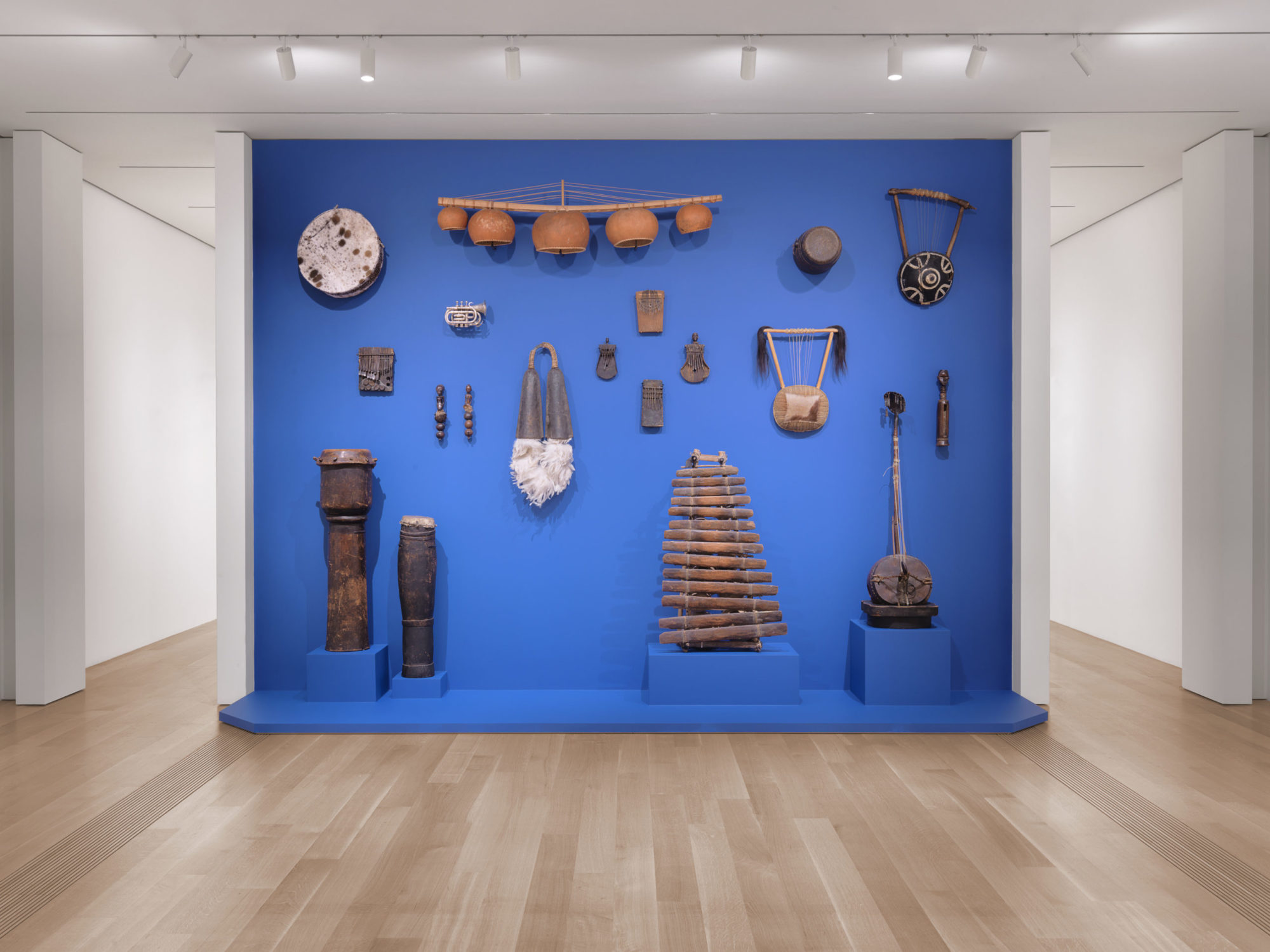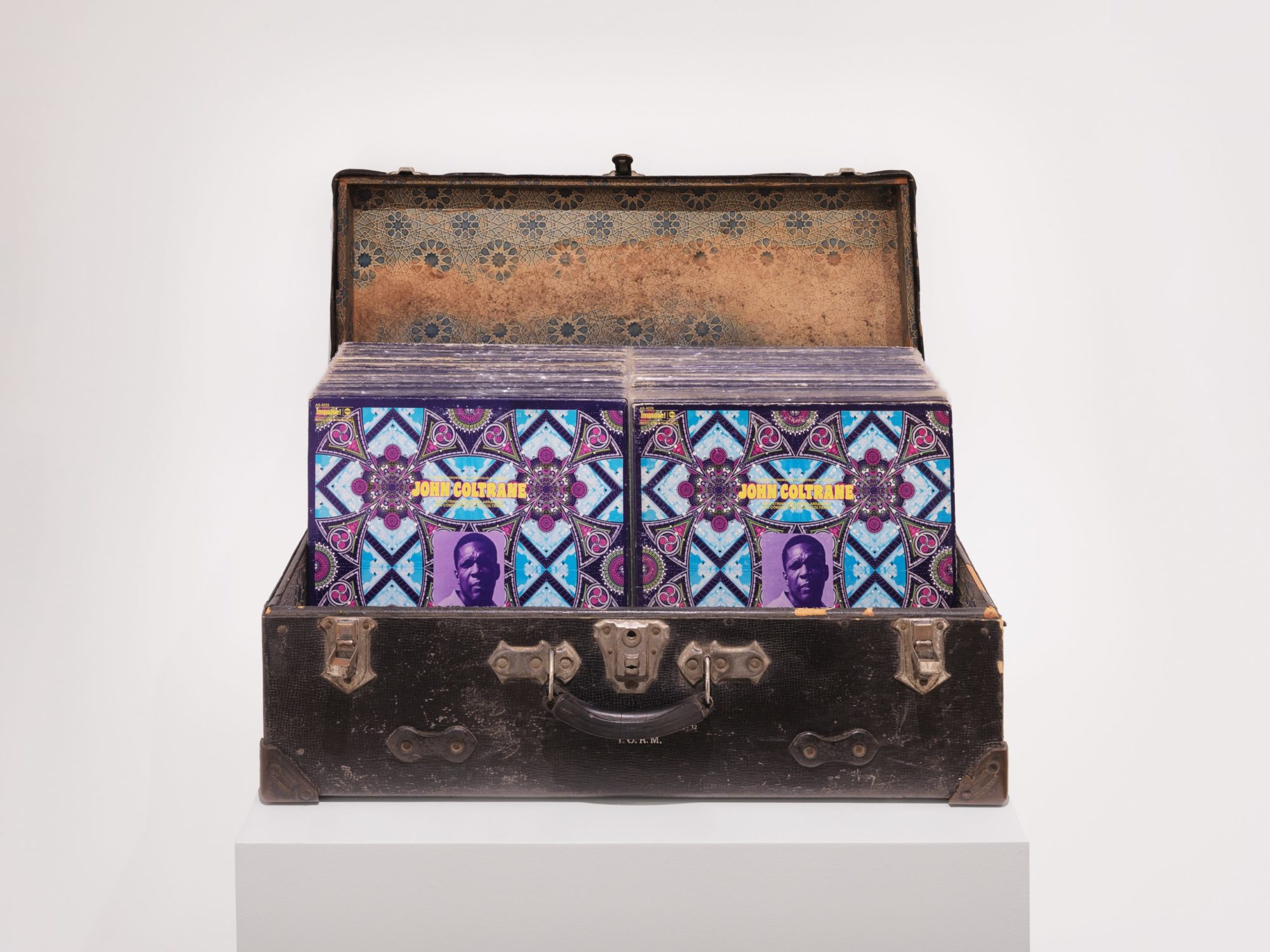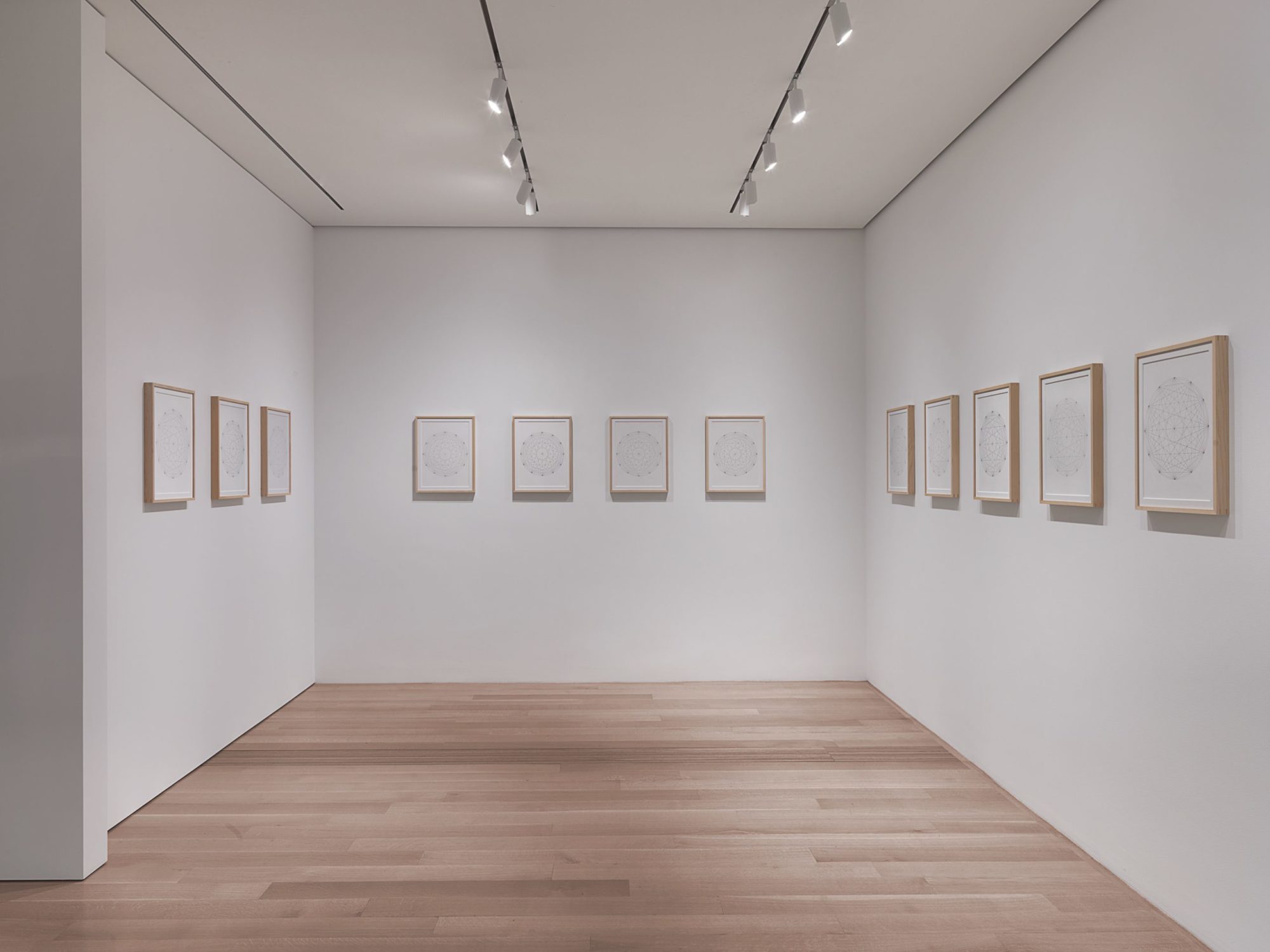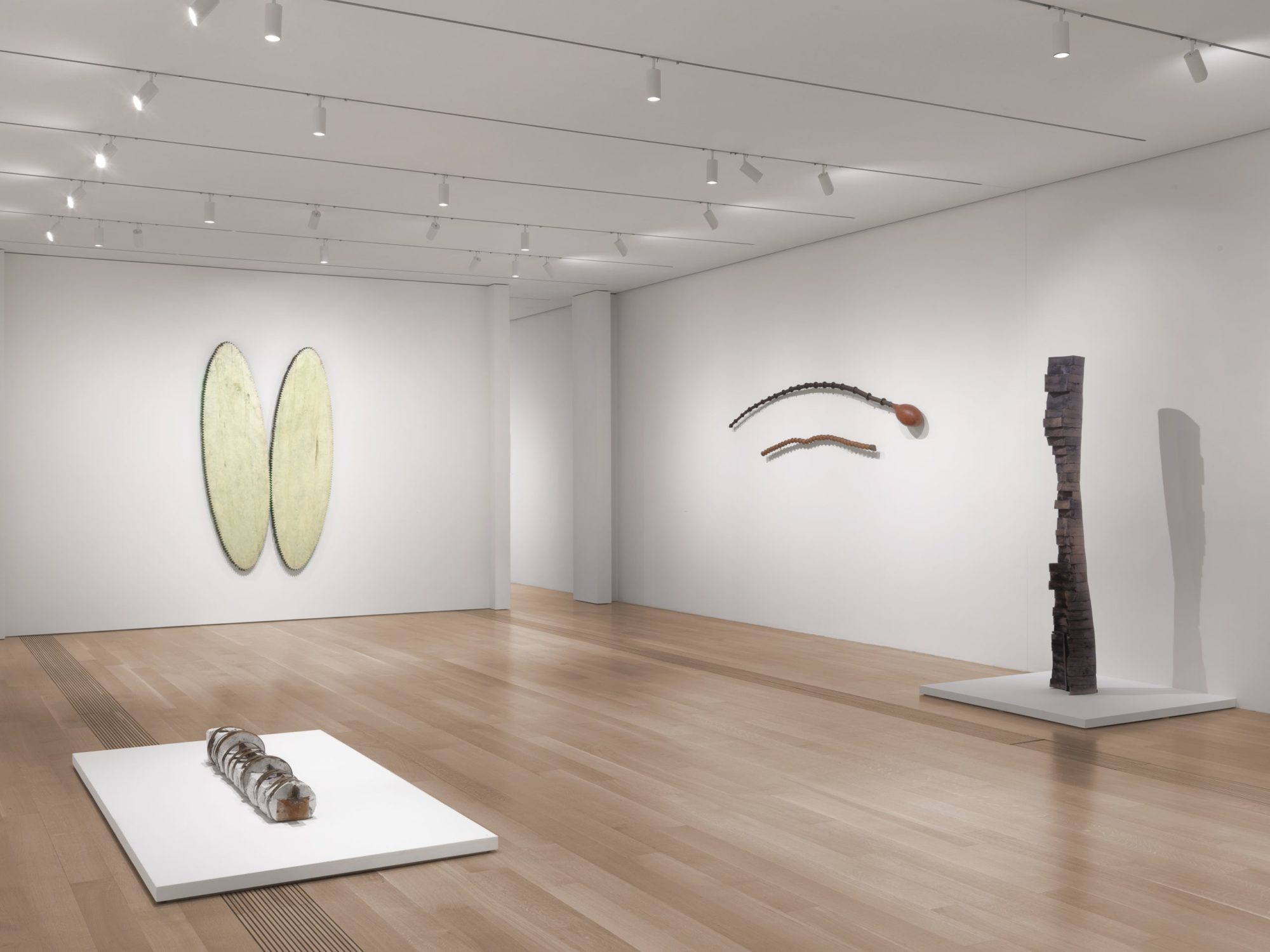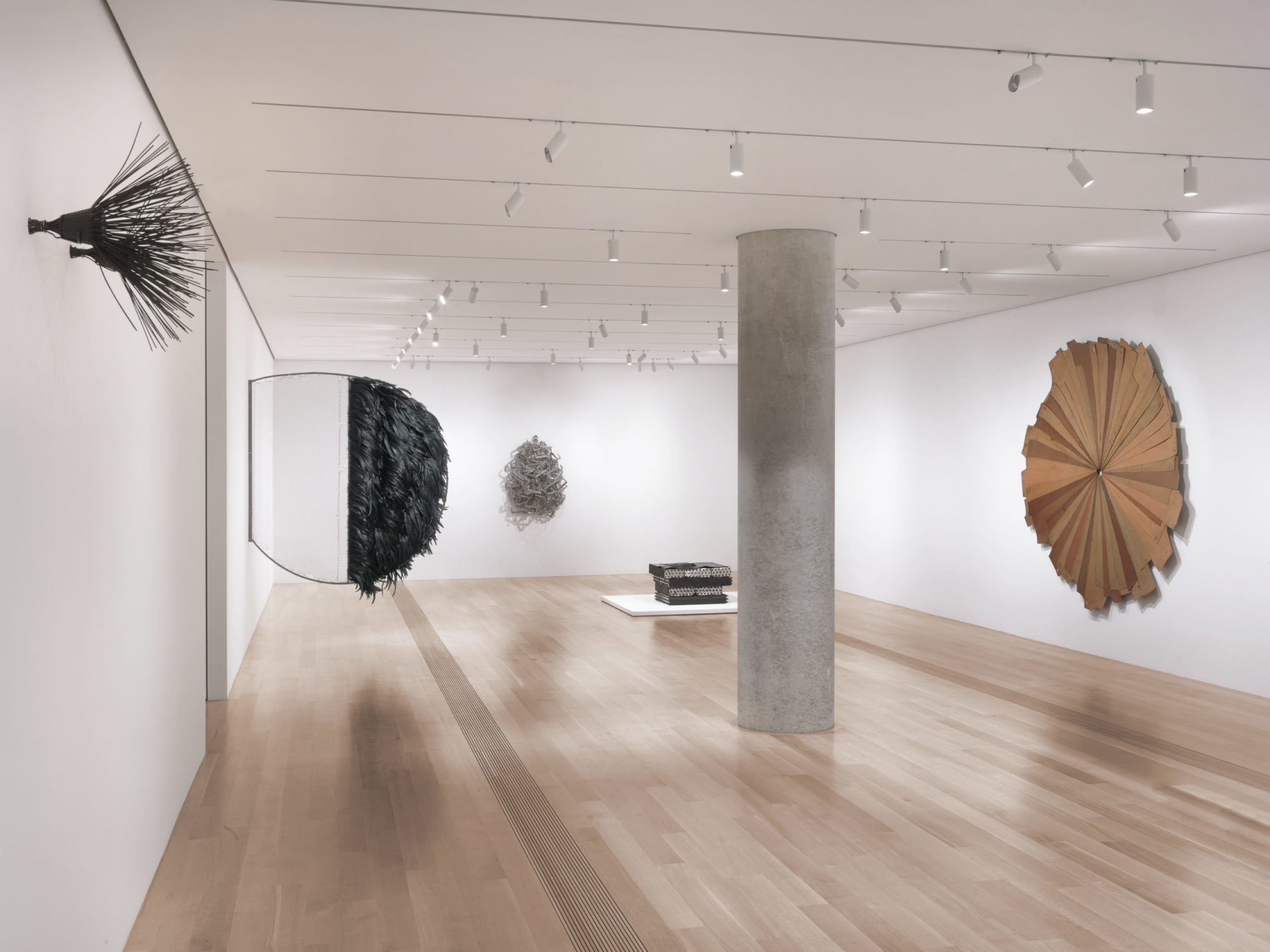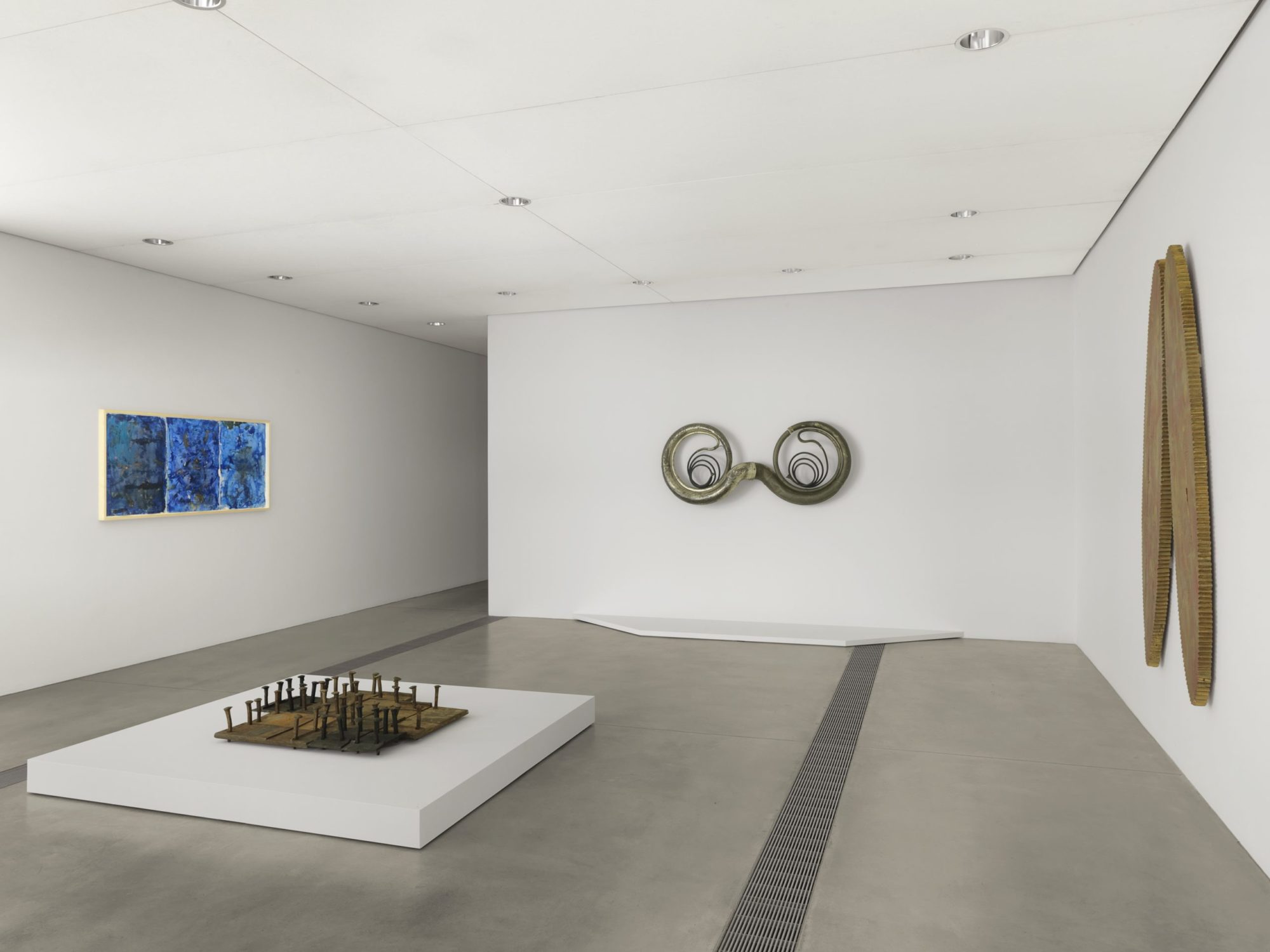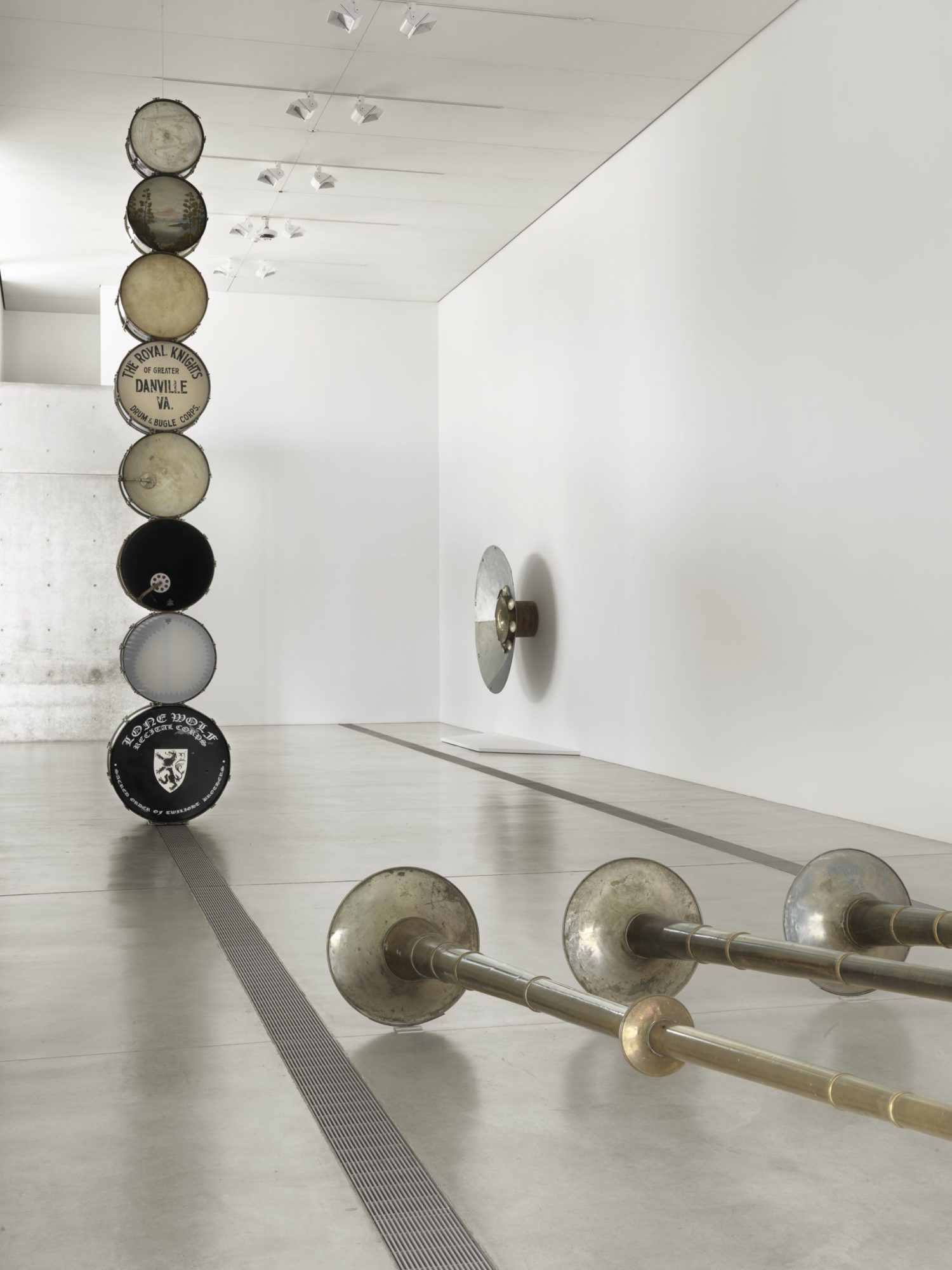Terry Adkins: Resounding
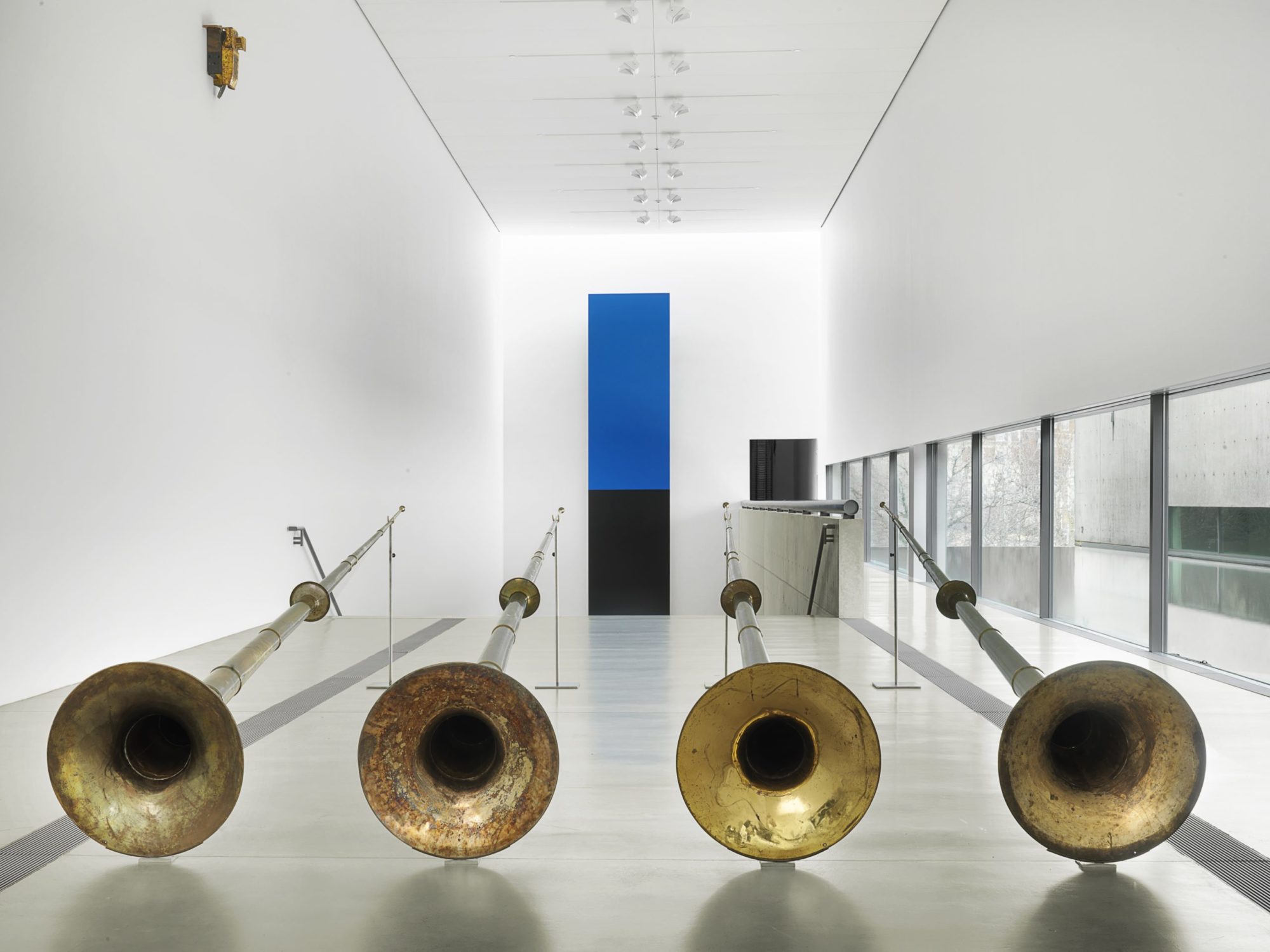
Terry Adkins: Resounding, installation view, main gallery, Pulitzer Arts Foundation, 2020 [photo: Alise O’Brien Photography; courtesy of the Estate of Terry Adkins / Artist Rights Society (ARS), and the Pulitzer Arts Foundation, St. Louis, MO]
Share:
Terry Adkins’ singular ingenuity flowed from a dynamic personal infrastructure: a creative practice at the intersection of music, visual art, and African American history. His ingenuity was propelled by these sensibilities: the devotion of being a collector, a poetic and pantheistic intuition, the informed openness of improvisation, a profound belief in the semiotic possibilities of abstract visual form, and his capacity for commemoration. Terry Adkins: Resounding’s poignancy and uniqueness dwell in a comprehensiveness that underscores these sensibilities. The exhibition’s title, Resounding, suggests the symphonic fullness of Adkins’ expressions in sculpture, sound, video, and printmaking. Its present tense signifies the works’ ongoing actions—their emanations, dialogues, rhythms, breathing, tolling.
Featuring more than 40 of Adkins’ multimedia works that were made over the course of three decades, the exhibition also includes selections from the artist’s personal collections of books and musical instruments, as well as art objects and cultural artifacts from a variety of traditions. Collecting was crucial to Adkins’ art. Consequently, this component of the exhibition has a central function and not an ancillary one. The objects from Adkins’ collections offer a valuable glimpse at his range of influences and emphasize the role of collecting in his artmaking—the attentiveness and cultivation of meaning that define collecting as a personal and cultural practice. Many of his works are found objects or consist of juxtaposed and/or altered ones. His dialogues with the selected objects involved a meditative process he described as “potential disclosure,” which included periods of “gestation” for the objects, after which they were invested with transformed purpose. Adkins’ process was a poetic synthesis of a Duchampian conceptual practice; an Allan Kaprow–esque aesthetics of the everyday; and Adkins’ unique sensibilities analogous to the intuitive, sensuous interpretations of improvisational jazz.
Terry Adkins: Resounding, installation view, main gallery, Pulitzer Arts Foundation, 2020 [photo: Alise O’Brien Photography; courtesy of the Estate of Terry Adkins / Artist Rights Society (ARS), and the Pulitzer Arts Foundation, St. Louis, MO]
Greater Deeps (1995) adapted and regenerated from a wood and rusty metal toy truck, is among many examples of this range of operations. Created as a memorial to his father, who died in 1995, Adkins associated this work, according to the exhibition guide, “with religious themes, including death, resurrection, and the soul’s departure from the body.” Accordingly, it hangs high on the wall of the Pulitzer’s main gallery to signify its spiritual message. Related to the vital process of “potential disclosure,” Adkins said: “When I am most successful, the work of art becomes illuminated, retaining the brilliance of the revelatory experience that created it.”
Another work, Infinity (1972–2014), installed in the Lower East Gallery of the museum, enlisted a self-directed, methodical act of collecting—one derived from Adkins’ self-imposed atonement for shoplifting a copy of the 1972 John Coltrane album, Infinity, when he was nineteen. From that year onward, and for the rest of his life, he promised to buy a copy of the album whenever he encountered one. Fittingly, Adkins’ straightforward assemblage consists of 75 albums symmetrically filed in two columns inside an opened vintage steamer trunk, the lining of which faintly echoes the kaleidoscopic patterns of the record sleeve. The stocked trunk, a treasure chest brimming with Coltrane’s “potential disclosure,” suggests connotations of the album’s title. It represents the vast multiplication of Coltrane’s masterly interpretations. In this context of expansive possibilities, it is interesting to note that the controversial album was produced after Coltrane’s death by his wife, Alice Coltrane, as a technical collaboration that included superimposed and redubbed recordings—an imagined extension of the saxophonist’s late visionary work.
Terry Adkins, Infinity, 1972-2014, cherokee trunk and John Coltrane “Infinity” albums [photo: Alise O’Brien Photography; courtesy of the Estate of Terry Adkins / Artist Rights Society (ARS), and the Pulitzer Arts Foundation, St. Louis, MO]
Terry Adkins, Infinity drawings, ca. 2010-13, graphite on paper, 19 x 13 inches [photo: Alise O’Brien Photography; courtesy of the Estate of Terry Adkins / Artist Rights Society (ARS), and the Pulitzer Arts Foundation, St. Louis, MO]
Adjacent to Infinity is an installation of 13 selected works from Adkins’ Infinity drawings, a lengthy series begun in 2003 that he worked on every morning and evening until his untimely death in 2014. Modest in scale, these graphite works on paper are contour drawings that echo one another in structure and allude to the geometric patterns within the sculpture, Infinity. Adapted from Coltrane’s famed 1960s sketch of a twelve-tone musical scale, sometimes referred to as “Coltrane’s Circle of Tones,” and made at a time when the musician was exploring Indian music and Albert Einstein’s quantum theories, Adkins’ drawings in number, process, and symbolic form evoke meditation and personal transformation through intentional transcendence.
Adkins regarded the repetitive making of these drawings as another “way of doing penance”—a kind of spiritual/secular rosary that, in tribute to Coltrane, he likened to practicing a musical instrument and “retracing” Coltrane’s sketch. The Infinity drawings can also be considered in relation to Adkins’ study of Dante’s Divine Comedy, a keystone in his personal library that he read at least 20 times and referenced often in his art, especially the book’s theme of individual transformation through the consecutive stages of Inferno, Purgatorio, and Paradiso. Adkins acquired dozens of copies of the iconic narrative poem, some of which are included in the collection component of the exhibition. The recurring forms in the Infinity drawings can be viewed as a geometrical transformation of the overall structure and organic forms visible in Gustave Doré’s archetypal engraving of the Empyrean, the dwelling-place of God as pure light that Dante encounters at the conclusion of Paradiso.
Terry Adkins: Resounding, installation view, Lower East Gallery, Pulitzer Arts Foundation [photo: Alise O’Brien Photography; courtesy of the Estate of Terry Adkins / Artist Rights Society (ARS), and the Pulitzer Arts Foundation, St. Louis, MO]
Terry Adkins: Resounding, installation view, Lower West Gallery, Pulitzer Arts Foundation [photo: Alise O’Brien Photography; courtesy of the Estate of Terry Adkins / Artist Rights Society (ARS), and the Pulitzer Arts Foundation, St. Louis, MO]
Five works, each in various mediums, occupy the entrance gallery at the Pulitzer. These works serve as a preface for the overall exhibition, presenting an outline of Adkins’ formal vocabulary that streams through more ambitious works, including his celebrated “recitals,” two of which are included in Resounding. An untitled readymade—a worn, short leather strap displaying four brass bells and two brass crotales—represents Adkins’ interest in sound, music, and performance. Sometimes worn by Adkins during performances, this work denotes a relationship to movement and sound. The cool Duchampian connotations of the term readymade hardly apply to the warm ambiance and receptivity of Adkins’ found objects, though. Duchamp’s attention to the act of selection and the sway of context were equally important for Adkins, though in different ways—perhaps mostly a matter of conceptualization and philosophy versus intuition and expression.
Installed on the entrance gallery floor, the collaged rusted railroad plates and spikes of High Point (1993), found by Adkins in Greensboro, NC, signify the region’s industry as well as the influence of his hero John Coltrane, who was born in Greensboro. The irregular grid of the sculpture’s figure, accentuated by the perpendicular railroad spikes, suggests a cubist translation of a saxophone (with the spikes as keys) by fusing a likeness of Coltrane’s instrument with a gritty material culture from the Southern city.
The end wall of this space holds the symmetrical sculpture Nenuphar (1998), a union of the curving main chambers from two found brass and copper sousaphones. Nearly six feet in width and three feet in height, the symmetrical shapes of this slightly comedic piece resemble an inverted volute atop the shaft of an Ionic column. The two overdone, eccentric interior scrolls mirror each other in shape and scale. At the interior terminus of each is a sousaphone mouthpiece, suggesting a functional, though irrational purpose. Like Nenuphar, the diptych Mvet Majestic II (1989) represents Adkins’ career-long interest in symmetry, repetition, and mirroring. Made of wood and painted with acrylic, the two narrow, inwardly tilting ellipses suggest a pair of lungs. The title reveals Adkins’ attachment to the mvet—a stringed instrument of the Fang people from Central Africa—one of which he owned. The fifth work in the entrance gallery is an untitled and undated mixed-media drawing on paper. The energy within the abstract triptych’s bottomless blue surface shows a savvy exploration of gesture, layering, excavation, and potential narratives of process and the passing of time.
Terry Adkins: Resounding, installation view, entrance gallery, Pulitzer Arts Foundation [photo: Alise O’Brien Photography; courtesy of the Estate of Terry Adkins / Artist Rights Society (ARS), and the Pulitzer Arts Foundation, St. Louis, MO]
A refrain throughout Adkins’ career was to pay tribute to select individuals or groups who had inspired and blessed his life, or to those whose accomplishments had been marginalized in the arts or by society. Fearless in his challenges of conventional narratives, he once said, “[I am] engaged in an ongoing quest to reinsert the legacies of unheralded immortal figures to their rightful place within the panorama of history.” Adkins had a nose for seeking out fissures in various historical and cultural texts. Across his creative practice, numerous subjects were the objects of his attention and intention for shedding light.
The sculpture Divine Mute (1998) pays homage to the spiritual awakening of the abolitionist John Brown that led to his controversial activism leading up to the Civil War. Social justice advocate W.E.B. Du Bois; marchers in the 1917 Silent Protest Parade in New York (which Du Bois helped organize); and victims of the 1917 East St. Louis riots, in which numerous Black residents were killed, are commemorated in Muffled Drums (2003), an imposing but fragile tower of eight bass drums, worn from use—a chain of beats and marching that leads to the heavens. Various sculptures and installations that were part of the 2003 recital Towering Steep use references to blues music to commemorate anonymous workers at the former Finesilver Uniform Factory in San Antonio, TX, and participants in the Great Migration, a period between 1916 and 1970 when more than six million African Americans moved from the South to cities and towns in the Northeast, Midwest, and the western US.
Terry Adkins: Resounding, installation view, main entrance, Pulitzer Arts Foundation [photo: Alise O’Brien Photography; courtesy of the Estate of Terry Adkins / Artist Rights Society (ARS), and the Pulitzer Arts Foundation, St. Louis, MO]
There is a measure of light in Adkins’ quest to make sculpture “as ethereal as music”—an inverted echo of his desire to “make music as physical as sculpture” (which became an enterprise of the Lone Wolf Recital Corps, a rotating group of musicians and artists who performed at his installations). Simultaneously, the light in Adkins’ work functions as an opaque and tactile thingness generated by the needs, desires, calls, and responses of humanness. Adkins’ aesthetic practice was a kind of pantheism that preserved as it transformed, one that synchronously looked down and into as it looked up and outward, and was as physical as it was metaphysical. His light-objects are active, fluid, effusive. They “body” like Martin Buber’s tree—his concept of I-Thou—and are in a reciprocal, mutual relationship with the viewer-participant.
Resounding reveals Adkins’ life and studio practice as a song of immanence and transcendence, in a continuous flow between these states, and where, within the worn objects of attics, secondhand shops, junkyards, shuttered schools, factories and industrial sites that are transformed into art, Adkins spins an idiosyncratic yet familiar light. Reflecting his signature practices of paying attention, intuitive listening, empathy, transformation, and commemoration, Adkins’ art is an ode to and of light. His works are light-objects. They thrive on their opacity, tactility, and density. Through these qualities, Adkins’ works function like inverse prisms. That which is absorbed is disclosed again as a resonant sheen. Whereas a typical prism disperses and reflects light through transparency, Adkins’ works absorb then disperse light through opacity. The usedness, history, and stories of Adkins’ light-objects glow, both literally as a soft patina and figuratively as grace.
In his liner notes for the seminal 1965 album A Love Supreme, John Coltrane states that “one thought can produce millions of vibrations and they all go back to God … everything does.” By substituting the word “object” for “thought” in Coltrane’s sentiment, one arrives at the ever-unfolding prompts for Adkins’ “potential disclosure,” the core of his creative practice that emerged from his engaged intuition and creative acts.
Paul Ryan is a painter and has been a contributing editor for ART PAPERS since 1990. He is professor of Art at Principia College (Illinois), Professor Emeritus of Art at Mary Baldwin University (Virginia), and he taught critical theory for 11 years in the MFA program of the Department of Painting and Printmaking at Virginia Commonwealth University.
